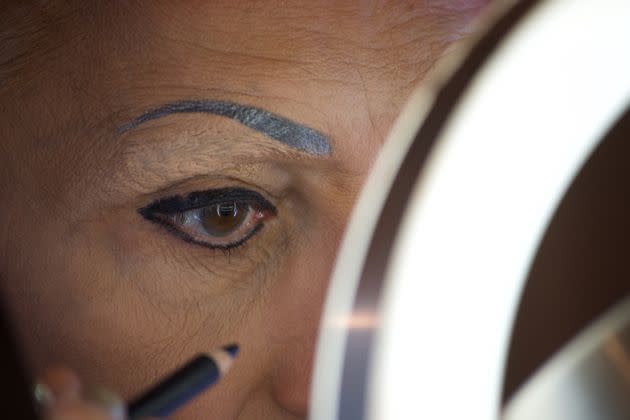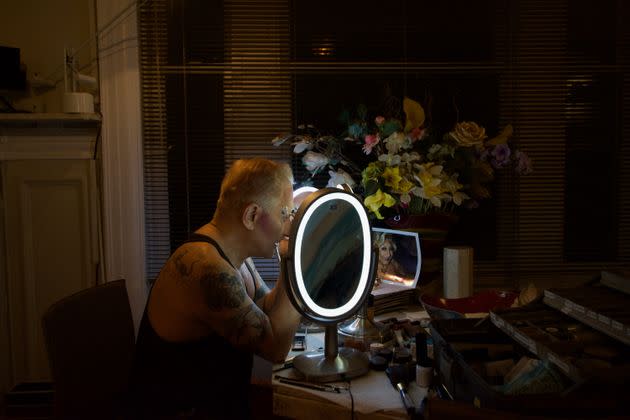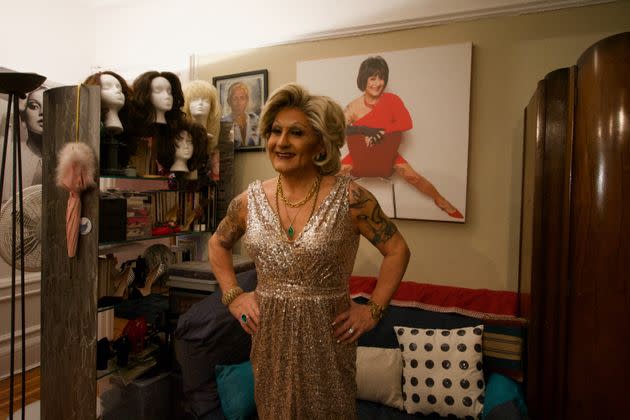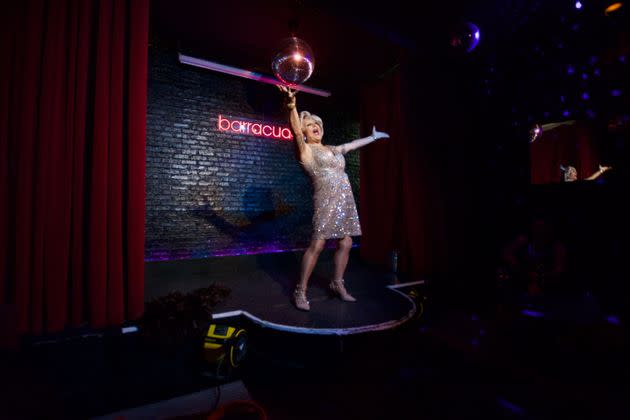Tales Of An Aging Drag Queen

Onanygiven Thursday, around 6 p.m., John Sefakis starts his weekly transformation into Stella D’oro, his drag persona. Facing three lighted mirrors and in front of a bouquet of bright, plastic flowers, the 74-year-old Greek American slicks down his thin, dark eyebrows with a glue stick, making sure that every hair is laid flat. On this particular night, he is performing at the Barracuda Lounge, a gay bar in New York City’s Chelsea neighborhood, he tells me as I stand next to a living room table, now transformed into an improvised vanity.
Every year that passes, getting into drag becomes more arduous. Even with stencils, Sefakis struggles to design the eyebrows. “I gotta make sure that they’re sort of even,” he says. “Some people paint them in. I have no arm for painting.” His naturally aging skin also makes the process more complex; while applying powder to get a smoother appearance, he needs to avoid the skin around his eyes. “I see what the queens do on ‘[RuPaul’s] Drag Race’ when they make up. They are so severe because they don’t have any wrinkles,” he says. “Which I can’t do because I’d be Wrinkle City.”

At a certain age, many drag queens hang up their heels for good, leaving the stage to the next generation — artists who meet audiences’ demands for acrobatic moves such as death drops. “Now that drag queens are expected to perform ball moves like duck walks and dips, there’s this valorization of the really agile body,” says Kareem Khubchandani, an associate professor of theater, dance and performance studies at Tufts University who is also the author of “Decolonize Drag” and a drag performer under the name LaWhore Vagistan.
Not so for Sefakis, who, along with a cohort of elder queens, is not planning to retire anytime soon. Staying in the game, however, isn’t easy. Routines must be altered to accommodate the aches and pains of aging, especially for older queens who manage underlying medical conditions. The lack of a solid economic safety net due to a reliance on tips also affects mature drag queens’ well-being. And with states like Tennessee adopting anti-drag legislation and drag performers getting death threats, this “form of entertainment [and] performance practice used for protests and education,” as Khubchandani defines it, is in jeopardy.
Moreover, pop culture — and the queer community at large — prioritize younger performers by far. Out of the more than 200 contestants across 16 seasons of “RuPaul’s Drag Race,” only eight were 40 or older when they participated. “In the gay community, if you’re over 30, you’re dead,” says Charlie Hides, 59, the oldest contestant to ever appear on “Drag Race,” in a video interview from the U.K. “Basically, I’ve been dead for 30 years.” Hides, who famously cracked a rib during the competition, has had to make art and costuming adjustments over time. “I was known in England for climbing up on top of the speakers and jumping off the bar wearing 9-inch heels, and I’m a little more careful these days,” she says.
D’oro was born in 2003, when Sefakis was in his mid-50s. It was his first time in drag. He was vacationing in the Poconos when he saw a mediocre drag show and offered his help. “No, bitch, you have to be in the show,” the organizers responded. So he went back the following year with a cheap wig and a “Chicago” performance as Stella D’oro — a name suggested by a then-roommate’s blind date — and won the contest. “Don’t let Stella die,” begged an old spectator.
!["I see what the queens do on '[RuPaul's] Drag Race' when they make up. They are so severe because they don’t have any wrinkles," Sefakis says. <span class="copyright">Alex Maroño Porto</span>](https://s.yimg.com/ny/api/res/1.2/SeVS.u9xiI1kBZP1yKbMew--/YXBwaWQ9aGlnaGxhbmRlcjt3PTk2MDtoPTY0MA--/https://media.zenfs.com/en/the_huffington_post_584/b0c7947c0657bdeaabe3004c189c259f)
He didn’t. Therapy, a club in Hell’s Kitchen, became this persona’s first drag home after she performed her “Chicago” number there and won a contest. When asked how she would spend the $100 prize, she said that she would invest it in Project Achieve, a program to develop an HIV vaccine. D’oro became the “Queen of Vaccine,” and hosted Vaccine-O-Licious, a show to educate on HIV vaccine trials.
Hides and D’oro are not the only drag queens who have adapted to the limitations of an aging body. Raven O, who did drag for the first time in the mid-1980s, echoes Hides’ physical concerns in a phone interview. “I’ve had five surgeries on my spine, so I can’t wear heels,” the silver-haired Hawaiian performer says. “It takes a lot of work to do drag. It’s not like throwing on a suit and going out there.”
Navigating health issues is the biggest challenge for older queens, Raven O tells me. And some queens such as Ruby Rims, 70, are long-term HIV survivors. “Thirty-two years ago, I was diagnosed with AIDS,” Rims says in a video interview from her Manhattan apartment. “But the only downfall of surviving AIDS is that you get old. I got through the AIDS crisis and now I’ve got more shit to deal with.” The curly-haired queen tells me that she will soon need two knee replacements. But memorizing lyrics is her true issue. “It takes me a lot longer to learn them,” she says. “And years ago, once I learned something, it was in my head.”
At the dressing table in his home, Sefakis continues to craft D’oro. With the eyeliner, he needs to be precise, so he slides the brush carefully over his hooded eyelids before applying a golden eye shadow in abundance. His black cat, Shequida, struts across the living room, uninterested as Sefakis turns to his mouth, enhancing his “Angela Lansbury lips,” as he calls them, by lining them with a plum-colored pen.
When his makeup is done, Sefakis puts on his undergarments, including a cincher and a bra to hold him ever tighter. His age prevents him from tucking, as many younger drag queens do. “I don’t tuck because I need to go to the bathroom,” he says. Once his legs are covered with a pair of shimmery tights, he dons a sequined dress he bought six years ago at a Rent the Runway sample sale for $10. “I wear it very rarely. I have so many clothes,” he says. As he turns, the sparkly dress exposes one of his most personal tattoos: a design on his upper back with Greek letters reading “Stella” — his grandmother’s name.
Sefakis chooses a vibrant-blond, medium-length wig out of the approximately 20 he has in his apartment. As Sefakis poses in front of a psychedelic mirror with a green-and-purple pattern in his kitchen, he reminds me of a traditional grandmother strutting through the streets of A Coruña, my Spanish hometown, cloaked in an elegant mink coat.

At 9:45 p.m., Sefakis, now fully transformed into D’oro, orders a Lyft from her apartment to Barracuda. She usually spends around $200 a month to get there — a significant amount considering that she doesn’t get tipped every week. For many drag queens, the economic struggle is the hardest aspect of aging. Usually, these performers don’t get paid a fixed hourly rate at clubs, and thus rely on the audience’s tips (which are not always generous). Cash is an unreliable source of income, and many artists lack a safety net when they’re old, compromising their health care. Fortunately, Sefakis tells me he is on Medicare.
“When I started doing drag, it was a completely fringe art form. You really had to bust your butt to make money,” says Sherry Vine, a drag queen who began performing in 1990. “If you lived in New York City, you could make a living doing drag; you [just] had to work every single night. And if you weren’t in New York City, you probably had to have a day job and do drag on the side.”
But for older queens of color, some bars and clubs were off-limits, exacerbating their financial situation. Egyptt LaBeija, the godmother of the Royal House of LaBeija, believes the situation is “90% better” than when she started back in the early ’90s. As a Black transgender woman, however, “there’s a long way to go,” she says in a phone interview.
Harmonica Sunbeam, a drag queen who started performing 33 years ago as part of the ballroom culture, echoes LaBeija’s words. “There’s still some establishments and promoters who don’t hire as many drag artists of color as they should,” she says. “I think that will never go away.” According to the New York City Mayor’s Office for Economic Opportunity, the poverty rate for the 65 and older population — the demographic subset of some of the drag queens I interviewed — was 22.2% in 2019, the highest of any age group in the city.
And, to make things worse, there is a renewed social and political hatred toward drag artists. Rep. Marjorie Taylor Greene (R-Ga.) has tweeted that “Protecting your children from drag queen child predators is not a hate crime,” and Republican Senate candidate Kari Lake once wrote that “They kicked God out of schools and welcomed the Drag Queens. Let’s bring back the basics: God, Guns & Glory.”
Amid a sharp increase in anti-drag incidents, queens such as Mrs. Kasha Davis, a 53-year-old queen who participated in “Drag Race” twice, remain hopeful. “Hatred and anger is a beautiful, loud disguise for fear and ignorance,” she says. “The more that we are open and ourselves and stand up in representation, that matters for others who are growing up. That will give them the freedom to be exactly who they are, even if they are in a small town.”
“Hey queen mum,” shouts the bartender once D’oro enters Barracuda, a one-story, red-brick building. Tonight, she will be performing in Star Search, Barracuda’s weekly drag show that people say served as an inspiration for “RuPaul’s Drag Race.” Every Thursday, approximately a dozen queens compete to receive the audience’s cheers, and the one who receives the loudest applause obtains the $150 prize. Some queens bring in people to cheer for them. “Very hard to overcome that, especially when they bring their friends, of which I have none to cheer me on,” D’oro says.

Around 11:35, host Kizha Carr opens the show from the stage wearing a purple sequined dress. This night, seven queens are competing for the prize. Though diverse in terms of race and drag style, they’re mostly all young, confidently sipping their cocktails from a couch. Drinking from a water bottle, Sefakis patiently waits from his chair to perform.
For her number, D’oro prepared a dance to Lauren Bacall’s “But Alive,” a song from the 1970 musical “Applause.” Draped in a dark feather boa, “the world’s oldest drag queen,” as Carr calls her, takes the stage. “And I feel rotten yet covered with roses, younger than springtime and older than Moses,” she lip-syncs. She then stands on top of the bar’s pool table amid the approximately 25 patrons, dancing energetically.
“And I feel brilliant, bombastic, super fantastic,” D’oro utters before falling into a “senior citizen” death drop on stage to close her weekly number. “Alive, alive, alive!”
When she finishes, the public cheers loudly. Still, another queen named A’Nylah the Doll takes the prize, and D’oro leaves Barracuda just after midnight, continuing to bask in the warmth of adoration. Prize or no prize, she’s still got it.

